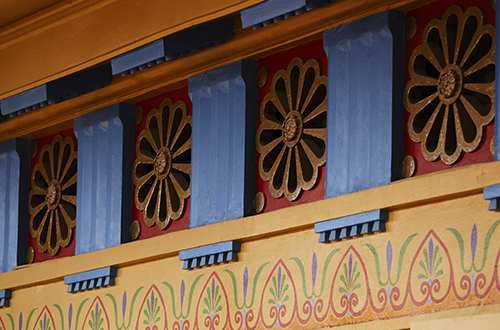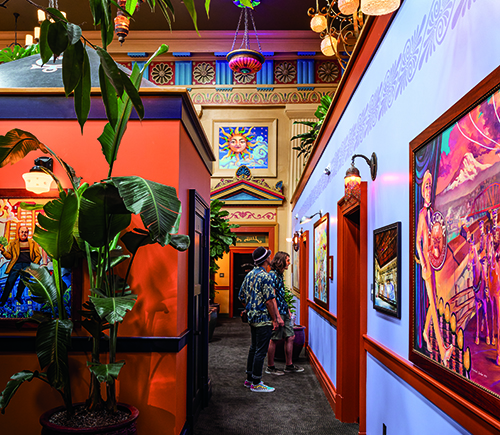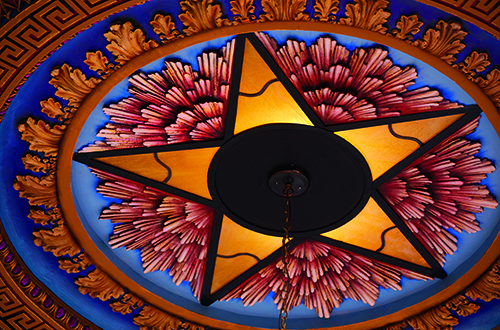After more than three decades of disrepair, a former Elks lodge in Tacoma, Washington, is reborn as a live music venue, hotel, brewery and five bars — all resplendent with color.
Last summer, Knife Knights — an innovative hip-hop duo repped by iconic Seattle record label Sub Pop — launched its 2019 North American tour at the McMenamins Elks Temple in Tacoma, Washington. It was one day after the newly renovated Elks Temple opened to the public, and the show was packed in the building’s 700-person-capacity Spanish Ballroom.
In many respects, though, the headliner that night was the Elks Temple itself. Originally built in 1916 by the Elks fraternal organization, it stood empty for more than 30 years in recent decades, and once-grand spaces, including the Spanish Ballroom, fell into decay and were covered floor to ceiling with graffiti. That’s when McMenamins — a chain of whimsical brewpubs, music venues and historic hotels with 55 locations in Washington and Oregon — stepped in, along with its architectural firm of 20 years, Ankrom Moisan, and architect George Signori.
“Because many of their buildings are historic and have often been neglected, they require a lot of structural attention,” Signori says. “And that’s part of the fun — how to creatively integrate that.”
Shoring up the structure happened alongside reimagining its square footage. “To feel good as a place to hang out and have a beer, you really need smaller spaces,” Signori says. The building’s vast, 28-foot-ceiling Temple Room, for example, was fitted with 20 hotel rooms (of the building’s total 45), many in the middle of the space so that the grand architectural walls and ceilings remain. The club’s former restaurant and athletic facilities were reworked to include a brewery and five bars. The Spanish Ballroom — complete with an elevated stage — was one of the only spaces that largely remained as is. “Everybody who has been through this building gets lost,” Signori says. “It’s a remarkable maze — almost like Venice, where a map is useless. Eventually, you’ll find your way out, but along the way, you’ll encounter some fun.”

Restored millwork in the Temple Room is painted in colors including Rhumba Orange SW 6642 (121-C6) and Secure Blue SW 6508 (175-C5).
In keeping with that spirit, the architectural team was careful not to apply too much polish. “With McMenamins, they prefer to keep their buildings a little rough,” Signori says. “They never like to make things look brand new. They embrace the bumps and bruises and scars that have developed over the years and that display the patina of time.”
They also added a layer of whimsical character for a look that’s become a trademark of sorts. “McMenamins always brings a troupe of artists and artisans with them,” Signori says. “Their plumber is a great plumber, but he’s a lot more than that.” Plaster workers set up shop on the temple’s fourth floor, casting plaster for months. And painters brushed walls, ceilings and architectural details with dozens of colors, from the low-key Tin Lizzie SW 9163 (236-C4) to the rousing Rhumba Orange SW 6642 (121-C6).

Hotel rooms built within the top-level Temple Room preserve the sense of scale of the 75-by-75-foot space as well as architectural details along perimeter walls and on the ceiling. Rhumba Orange SW 6642 (121-C6) and Awesome Violet SW 6815 (180-C4) cover most of the walls.
Rooted in History
Using so many colors may seem to defy conventional wisdom, considering the Elks Temple was originally painted white inside and out — part of the architectural movement that followed the 1893 Chicago World’s Fair’s “White City” and the use of classicism for city halls, libraries and other buildings. “Back then, the prevailing thought was that the architecture was white and white and white,” Signori says. “Architecture students were sent to look at the buildings in Greece and Rome.”
But archaeologists have since learned that these buildings weren’t all white after all. “Greek and Roman temples were actually fairly elaborate with color — they were painted,” Signori says. Working closely with Andersen Construction and SKIS Painting, he deliberated over dozens of color combinations, taking his cues from scholars’ renderings of classical schemes. “We went through four or five variations of blue to get it right,” Signori says. “And then once you put the blue next to the gold, the gold isn’t quite right, so you have to push the gold.” Walls and architectural features such as cornices, capitals and medallions now glow with color.

The Temple Room’s original plaster medallion — placed in the center of the room’s 28-foot-high ceiling — glows with color after years of disrepair. In some cases, however, architectural plaster elements had deteriorated beyond repair, so plaster workers set up shop on site to cast replacements.
Moving Outside
The exterior’s restored concrete with plaster skim coat glows again, too. It, however, remains white to tie in with the adjacent Spanish Steps — inspired by the Spanish Steps in Rome — that were originally built in tandem with the Elks Temple. And it will continue to look white for years to come, thanks to Loxon® Self-Cleaning Acrylic Coating, which is formulated to shed dirt upon rain or water contact.
That sparkling appearance should suit good times well into the future. But the impact of the renovation means more than that, Signori says. “Over the years, we’ve found that when you bring these buildings back, you also help bring the neighborhood back. That’s what makes preserving this building interesting to me. That’s a big part of the fun.”

Loxon® Self-Cleaning Acrylic Coating creates a look true to the building’s original appearance, but with an innovative update: It sheds dirt upon rain or water contact.
WATCH: Explore the Elks Temple with architect George Signori.
Photos: Jonnu Singleton




